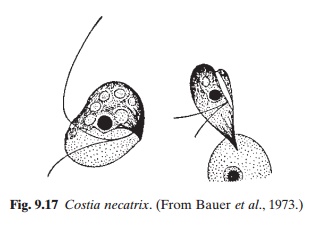Chapter: Aquaculture Principles and Practices: Health and Diseases
Ichtyobodosis - Protozoan diseases of aquaculture species
Ichtyobodosis
Ichtyobodosis, previously known as costiasis, is a severe disease affecting many species of fish, including common carp and trout, especially the younger age groups. It is caused by the flagellate Ichtyobodo necator (Costia necatrix) (fig. 9.17). The parasite attaches itself to the skin of the host. Its anterior end forms finger-shaped processes at the point of attachment, which penetrate into the cell of the host and suck its contents. The parasite multiplies by longitudinal division and dies when it falls from the host. Transmission takes place through water. Under adverse conditions, the body of the parasite becomes rounded.

It can live at temperatures ranging from 2 to 30°C or higher, but multiplies rapidly at 20–25°C. A pH of 4.5–5.5 is very favourable for mass reproduction. In carp farms, ichtyobodosis occurs frequently in spawning ponds at higher temperatures. The incidence of the disease decreases rapidly when the young fish are transferred to rearing ponds.
A characteristic symptom of the disease is the appearance of dull spots on the sides, which eventually become fused into a continuous grayish film by the increased secretion of mucus. The fins are frequently affected, starting with erosion of the tissue between the rays, which becomes exposed. The fry becomes emaciated and therefore the head looks enlarged. The infected gills are pale and covered with mucus. The fry rise to the surface and congregate near the inlet, swallowing air.
To avoid the incidence of the disease, young fish should be given nutritionally adequate food and should not be kept too long in spawning and rearing ponds. Carp spawning ponds should be disinfected with quicklime before spawners are introduced. Carrier fish should be eliminated and the water supply should be kept free from parasites. Ichtyobodo infections can be effectively treated in ponds with 15–50 ppm formalin, 2–3 ppm potassium permanganate or 0.1 ppm malachite green. A combination of 0.1 ppm malachite green with 15 ppm formalin has also been found to be effective.
Related Topics